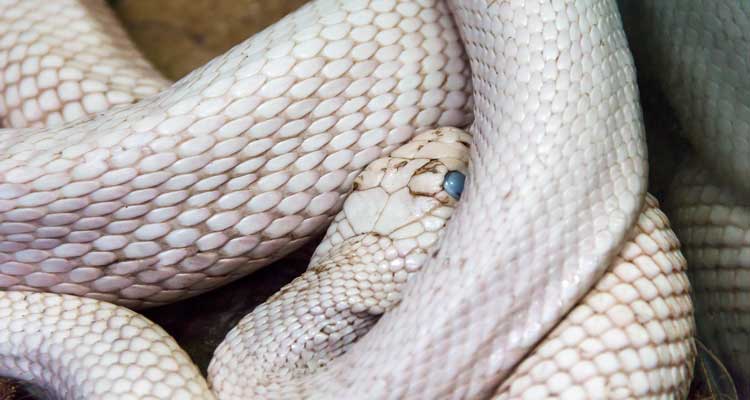Snakes of a wide variety of colors and characteristics are available to pets. But white pet snakes are the most exquisite and elegant of them. But These snakes do well with limited care and can be everyone’s snakes. Their exotic color creates an intriguing focal point for your terrarium.
Lack of pigmentation makes a snake white. These species are rare and very hard to find in the wild. Although breeders are now able to breed snakes of different colors and patterns.
The stunning beauty, elegance, availability, and price of the white snakes attract snake enthusiasts. Here are the 10 best white pet snakes suitable for almost everyone.
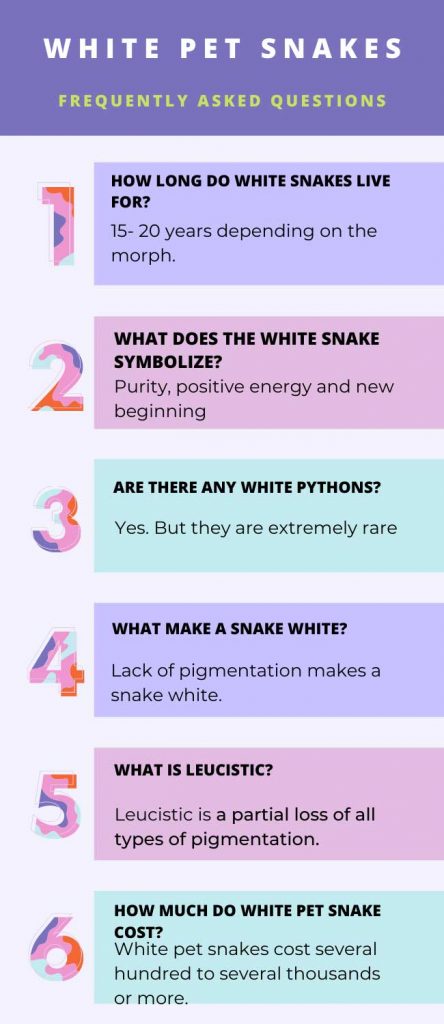
10 Best White Pet Snakes
Similar to many other snake species, the best white pet snakes are ideal for small homes. Indeed, they require less room than most other snake breeds which is especially important for people with limited living space. Read through this article to find out more about the white snakes.
1. Leucistic Texas Rat Snake
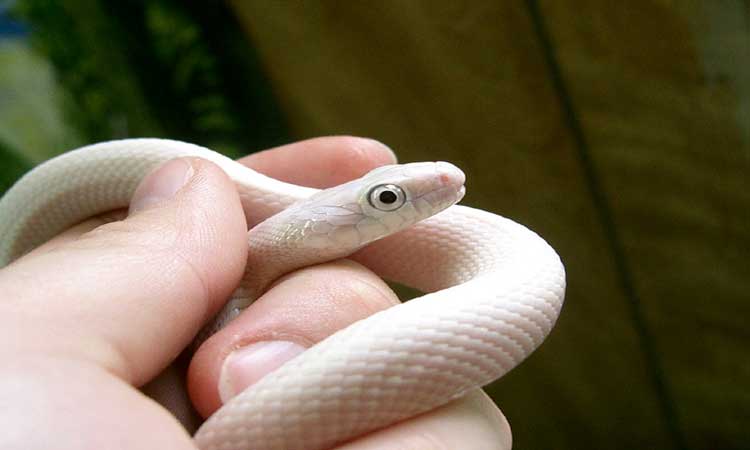
Leucistic Texas rat snakes (Elaphe obsoleta lindheimeri) have comparatively calmer personalities and are relatively easy to maintain among the many rat snake species.
The Leucistic Texas rat snake requires a larger enclosure, but beginners and experts can certainly meet its needs.
Longevity and a large size match its personality. Snakes like this are easily handled, and they are fascinating to watch as they burrow, forage, climb, and soak.
Snakes of the Leucistic Texas rat snake species usually have a neutral color, but this can change depending on their environment. Snakes from eastern Texas are grey, while those from central Texas are yellow. Snakes with red or orange skin beneath their scales are native to North America.
Their belly and head are usually lighter in color, usually white or gray. Single-colored ones have been spotted as well as those with blotches or stripes.
When they are hatchlings and juveniles, they are approximately one foot long (12 to 15 inches). They are approximately four to six feet long as adults.
A wedge-shaped head gives them their long, slender appearance. Their pupils are rounded like those of most nonvenomous snakes.
As long as they live, they should remain lean. Snakes that become fat or broad may be obese.
In comparison to their wild counterparts, captive animals are more likely to become obese. This can be avoided by keeping an eye on the snake’s diet and activity.
2. Snow Kenyan Sand Boa
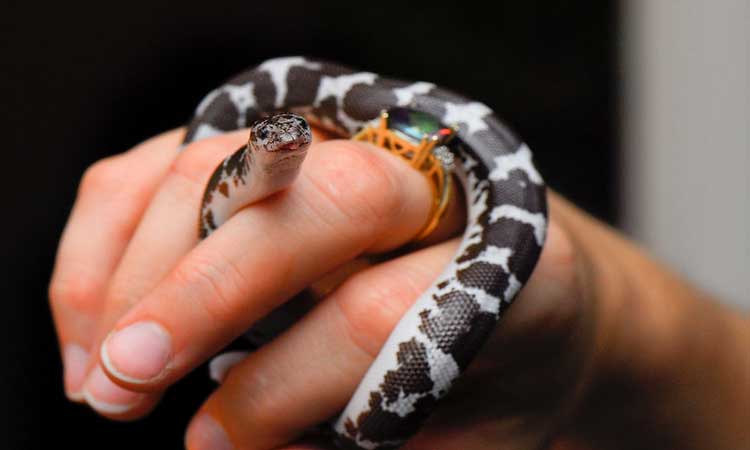
Burrowing snakes of this species are native to North-East Africa. Snow Kenyan Sand Boa is also known as the Kenyan Sand Boa (Eryx colubrinus). If you choose a white pet snake, it’s the best type.
Snow kenyansand boas are docile, round, and stout. These snakes are popular for their beauty, docility, and small size.
The body is orange with a dark brown blotch pattern similar to a dairy cow. Snakes of this coloration are truly unique.
The Snow Kenyan Sand Boa tolerates handling well, has simple husbandry requirements, and is not venomous, so it makes a great pet snake for beginners.
Snow Kenyan Sand Boas are old-world snakes found from Egypt to Niger and Kenya.
In the past, this snake was divided into two subspecies:
- Eryx colubrinus colubrinus.
- Eryx colubrinus loveridgei.
According to legend, the loveridgei subspecies occupied the southern ranges of Kenya and exhibited more vibrant orange tones. Herpetologists debate whether these species were separated.
Born in north-eastern Africa, Snow Kenyan Sand Boas usually live in sandy savanna regions. Being ambush predators, they dart out of burrows to attack passing prey in a loose, soiled habitat where they have plenty of room to burrow.
To avoid damage from sand, Sand Boas have small eyes and nostrils that allow them to breathe freely when waiting in burrows.
Keepers appreciate the docile nature, beautiful pattern, and tiny details of this species. They make beautiful pets because of their beady eyes and stubby tails.
Males and females of the Snow Kenyan Sand Boa typically reach 1.5 feet in length and 2.5 feet in length, respectively.
3. Black Pastel Ball Python
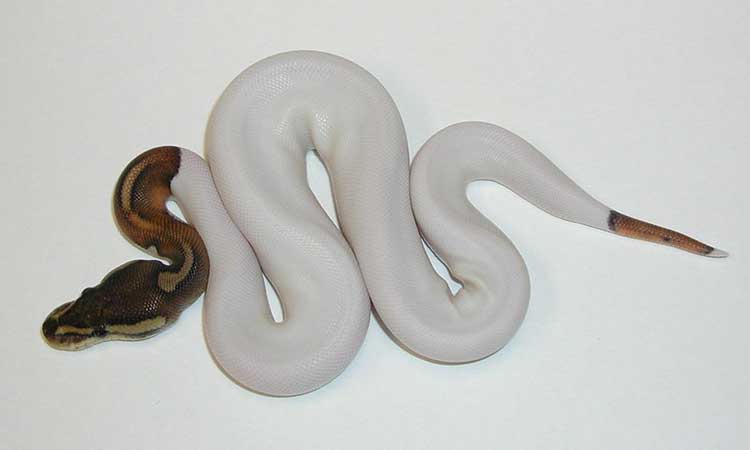
The Cinnamon morph is very similar to this one. However, they have different genetic lines. Black Pastel Ball Pythons look like normal Ball Pythons, but they have more contrast.
Their distinctive dark background coloration is largely responsible for the contrast. They also have a slightly different pattern coloration, which can be described as being golden or rusty.
It is a stunning animal to see the Black Pastel in Super form. This morph is almost completely jet black. Animals created with this gene have created some stunning morphs.
Pied and Super Black Pastel are combined in the Panda Pied. This animal is entirely white with black spots. Panda Pieds tend to be ‘high white’ Pieds, meaning there is a great deal of white instead of the background color.
4. Pastel Pied Ball Python
The Pastel pied ball python is a beautiful variation of the regular ball python. In addition to being easy to maintain, docile, and undemanding eaters, they also have appealing colors.
Their coloring is also an inherited recessive trait, so they don’t experience the same health problems as other morphs. As a result of their other features, they are the ideal choice for owners looking for a first morph.
Piebald ball pythons (often called pied ball pythons) are beautiful, docile, and require basic care. Since its origins in Africa, the ball python has become one of the most popular pet reptiles.
Ball pythons can live for up to 20 years, grow up to five feet long, and require a minimum of 60 gallons of water. Even though they’re suitable for all levels of experience, they’re long-term commitments.
Snakes of this type readily eat, handle well, and do not require specialized enclosures. If you want to keep a pied python, make sure it has at least 50% humidity and that the tank temperature is 75 – 85 degrees Fahrenheit.
It’s a good white pet snake if you want to keep snakes.
5. Blue Eyed Leucistic Ball Python
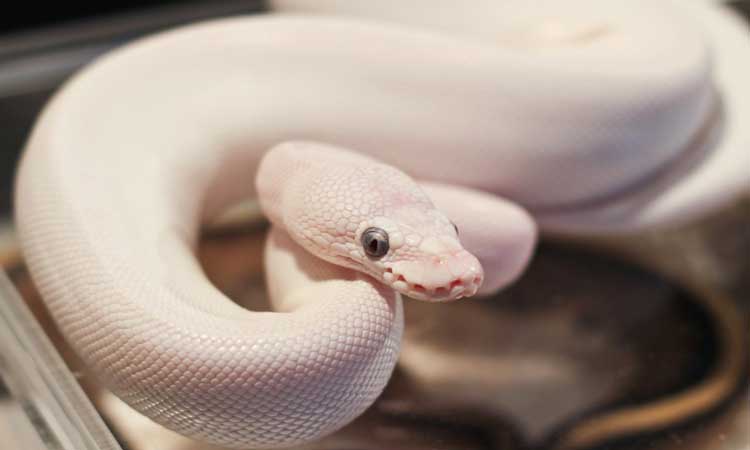
This is a morph of the white Ball Python that is known as a bel ball python. If your favorite color is white. You can choose it as your favorite white pet snake.
Their eyes are icy blue, and their pupils are black. The snakes are not considered albino due to their eyes, but their bodies lack pigment. This docile snake grows up to five feet long and is a great first snake.
This docile snake grows up to five feet long and is a great first snake.
Their origins can be traced back to common ball pythons from Africa. Herpetologists first became interested in ball pythons in the 1980s when they emerged in West and Central Africa’s grasslands and forests.
Professional snake breeders isolated the first recessive gene in 1992, resulting in the first clutch of morphs. The Blue-Eyed Leucistic Ball Python is one of the thousands of morph combinations discovered since then. Costs can be high and they can be hard to find – breeders usually charge $700 per snake.
6. Ivory Ball Python Morph
Snake lovers love ball pythons for a variety of reasons and they have good reason to do so. You can find them in just about any morph appearance you can imagine, and they are beautiful, low-maintenance, and affordable.
Pearl, peach, and beige tones make up the color palette of ivory ball pythons. Its average lifespan is 30 years old, making it rare and stunning. It is one of the white pet snakes, which lasts a long time.
7. Albino California Kingsnake
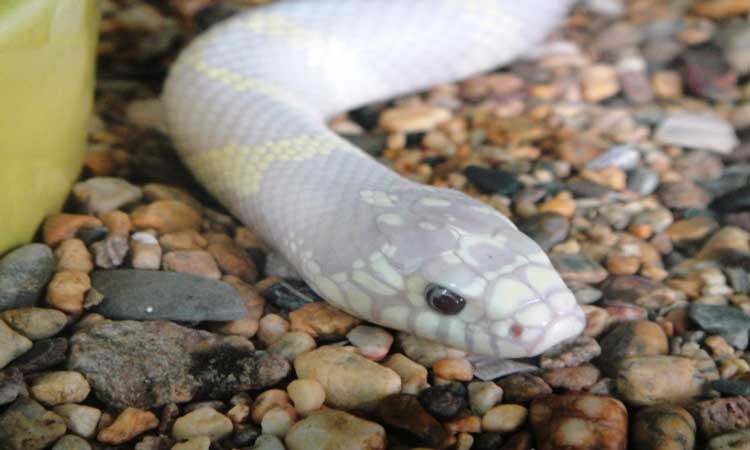
Albino California Kingsnake, also referred to as California Kingsnake, is a colorful reptile with a striped and banded body that resembles the skin tone of an albino. Between 1930 and 1944, it became known with different patterns, but within the same subspecies. In the beginning, the striped species was considered a separate species (Lampropeltis California) that originated from the south of the Baja Peninsula that was compared to Lampropeltis Nitida. It’s also a good white pet snake.
Albino California Kingsnakes can live up to 20 years in captivity, though the oldest ever recorded was 33 and a half.
Various colors of California Kingsnakes exist, from brown to black to yellow with white patterns. The different subspecies have striped versions as well as white and black specimens that are referred to as desert phases even though they may not have originated in deserts.
Albinos have pinkish coloration when they are young and yellow or white when they are older, but when their scales become thick and heavy, their color changes to white. Snakes of this species reach a maximum length of about 5 feet, but many reach an average of 4 feet. There are 21 to 44 bands on an adult striped albino Cali Kingsnake, 23 to 25 bands on the dorsal scales, and 213 to 255 bands on the ventral scales. Rodents, birds, lizards, snakes, even venomous species, and frogs are its main food sources.
8. Blizzard Corn Snake
Corn snakes with brightly colored, white skin are known as Blizzard corn snakes. These snakes originated in the United States but are now found in other countries as well, such as China and Australia.
Known for their bright colors, they make wonderful pets for anyone interested in owning one.
Corn snakes are generally very clean and easy to take care of, so they make excellent pets. Due to their lack of activity, they make an excellent choice for beginners.
They are generally much friendlier than other snakes. Humans are not poisoned by their bites, as they do not have venom. Blizzard corn snakes are not typically aggressive, but you should handle them carefully to avoid injury.
The snake is beautiful to look at, in addition to being an angel. Once your guests see your snake, they will be sure to leave a lasting impression.
Blizzard corn snakes are variations of regular corn snakes. The blizzard corn snake is distinguished by its white or cream-colored body. The corn snakes of this type usually have rows of dark black spots on their backs, unlike most other types.
9. Ghost Brooks Kingsnake
A thick-bodied colubrid snake, the Ghost Brooks Kingsnake reaches an average length of 4 to 6ft. Owners tend to use these as a ‘dustbin’ for uneaten rodents, so they will grow and become overweight if not monitored properly.
What makes Brooks King Snakes interesting is their coloration and patterning. Black-bodied babies are generally marked with thin yellow/cream brands along their backs, which then break up into a striped pattern on their sides.
Some babies can have orange/red scales in the side patterning. Each specimen shows different amounts of red. The animal’s black and red pigments begin to fade as it grows, and the animal appears to have a cream/yellow base color with darker spots.
It’s hard to see the bands of some Brooks King Snakes because they are so speckled. As this is merely where the animals were originally collected many years ago, this doesn’t mean your snake isn’t a Brooks snake if it stays darker in color.
The heads of these animals have a typical snake shape, without a distinct jawline, as if the head and neck are one. Snakes have large eyes and because of the patterning on their heads, they appear to frown constantly. As a snake grows, this tendency tends to disappear. Babies also have an attitude, recurring and striking out rapidly. A young snake is also prone to going to the bathroom while being handled, something it will quickly outgrow with gentle handling.
The Ghost Brooks Kingsnakes are diurnal (active during the day), but hide during the hottest part of the day and come out at night.
Young snakes should be kept in a 2-foot enclosure, while adults should be housed in a 4-foot enclosure. The heat mat connected to the pulse thermostat in the smaller enclosure will allow the snake enough warmth to aid in the digestion of its food.
The best way to increase the air temperature and provide a nice basking area in the larger vivarium is to use a ceramic lamp protected by a guard and connected to a pulse/dimming thermostat.
Snakes within enclosures are observed basking under UVB lighting, which has been shown to benefit all snakes. According to Ferguson’s Scale, the Brooks King Snake needs a zone 1. The fixture should be equipped with a low UVB bulb, which should be guarded to prevent accidental damage or burns to the snake.
Substrates for snake habitats can be made from aspen, lignocel, or soil/sand mixtures to mimic the natural environment of snakes. By providing the snake with a variety of enrichment, such as hides, branches, and plants, it will feel more secure and become more active within the enclosure. Snakes with only one or two hides will hide all day, while snakes with leaf litter and places to climb will be active during the day.
It is important to provide fresh water and let the snake submerge completely in its water bowl when it is shedding its skin. When the snake enclosure is damp in the morning, it will simulate mourning.
10. Snow Western Hognose Snake
Its scientific name is Heterodon nasiscus nasiscus (also known as the Plains hognose snake). It is an amazing white pet snake.
Snow Western hognose snakes have become popular to collectors worldwide as they are harmless. In the U.S., it is found from southern Canada through Arizona, New Mexico, and Texas to northern Mexico.
There are a variety of colors to choose from when it comes to Western hognose snakes. We have a peach specimen here.
With keeled scales and a sharply upturned snout, the creature can burrow and dig in loose sandy soils and hunt. Dark blotches or bars or rows of parallel spots run longitudinally along the body of western hognoses with tans, browns, grays, or olive background colors. Western hognoses have black, glossy scales that are usually interspersed with white, yellow, or orange.
A snow western hognose that is alarmed will also strike repeatedly with its closed mouth either forward or sideways. In attacks, snow western hognoses strike with their heavily keeled snouts but do not bite.
Furthermore, Western hognoses sometimes play dead when they have exhausted all other means of defense. With mouth agape and tongue lolling, the snake rolls onto its back. The snake will roll back onto its back when flipped upright by hand, which is quite amusing to witness.
It is not so amusing to witness this death act as the Western hognose sometimes squirts a foul-smelling musk from its anal glands on either side of the cloaca.
As for color phases, patterns, and genetic mutations expand, their ease of care, and uniqueness makes the Western hognose an attractive choice for new and seasoned reptile enthusiasts alike. Western hognoses have been one of my favorite snakes to work with and to keep for many years.
Check this out to know more about pet hognose snake
How Much A White Pet Snake Cost?
White snakes command a premium price because breeding and raising them takes years and is expensive. It is normal to expect to spend several hundred dollars more for an all-white snake than you would for a colored specimen of the same species.

